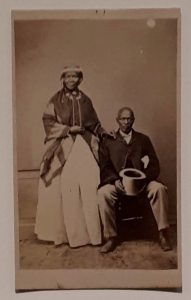The current exhibition at Ryerson Image Centre is The Way She Looks: A History of Female Gazes in African Portraiture.
Many of the 19th century portraits, especially from South Africa, were printed on something called a carte de visite, a format with which I wasn’t familiar. This terrific short video from the Art Gallery of New South Wales in Australia succinctly explains the phenomenon.
Here is an example of a carte de visite from the exhibition.

Apparently this small format, perfect for trading with friends, was enormously popular in Victorian times. Patented in Paris in 1854, the use of cartes de visite spread throughout Europe, then to the United States (especially during the Civil War), and the rest of the world, including South Africa, as shown in the Ryerson exhibit.
One thing I don’t understand yet, is how the cards were presented with no name on them to identify the subject(s) of the portrait. Perhaps it was customary to write this information by hand on the opposite side of the card?
I’m also interested in how these portraits were commissioned. The nature of the format would imply that it’s the (wealthy?) sitters who arranged for the images to be created, for their own distribution to friends. However the “documentary,” i.e. objectifying nature of some of the portraits, taken by exclusively male photographers, implies that the images of (bare breasted) female sitters are for consumption by others.
Nadine Froneman of the University of Capetown, South Africa, has written a 2014 thesis on the topic entitled Obsessive Collecting: Curiosity of Lost Objects and Unknown Narratives, an Archive of cartes de visite (opens a 161-page PDF), at which I’d like to take a closer look.
Ryerson Image Centre is museum no. 49 in my #100museums challenge (see 100 Museums Challenge).

